B01AUDT317 Auditing: AWA and HIH Corporate Collapse Case Analysis
VerifiedAdded on 2023/03/23
|11
|2787
|20
Case Study
AI Summary
This case study examines the corporate collapses of AWA and HIH, focusing on audit failures. The AWA case involves auditor negligence by DHS in identifying foreign exchange fraud. The HIH collapse, investigated by a Royal Commission, revealed misconduct, inadequate internal controls, and issues with Arthur Andersen's audits. Key audit procedure failures included ineffective post-balance procedures, inadequate communication of findings, lack of experience in foreign exchange transactions, and unqualified accounts. The study also addresses auditor independence, professional ethics, and improvements in audit standards, recommending the inclusion of forensic phases in audits to reduce the audit expectation gap. This analysis is based on transcripts, reports, and peer reviews to provide a comprehensive understanding of the audit failures and their consequences.
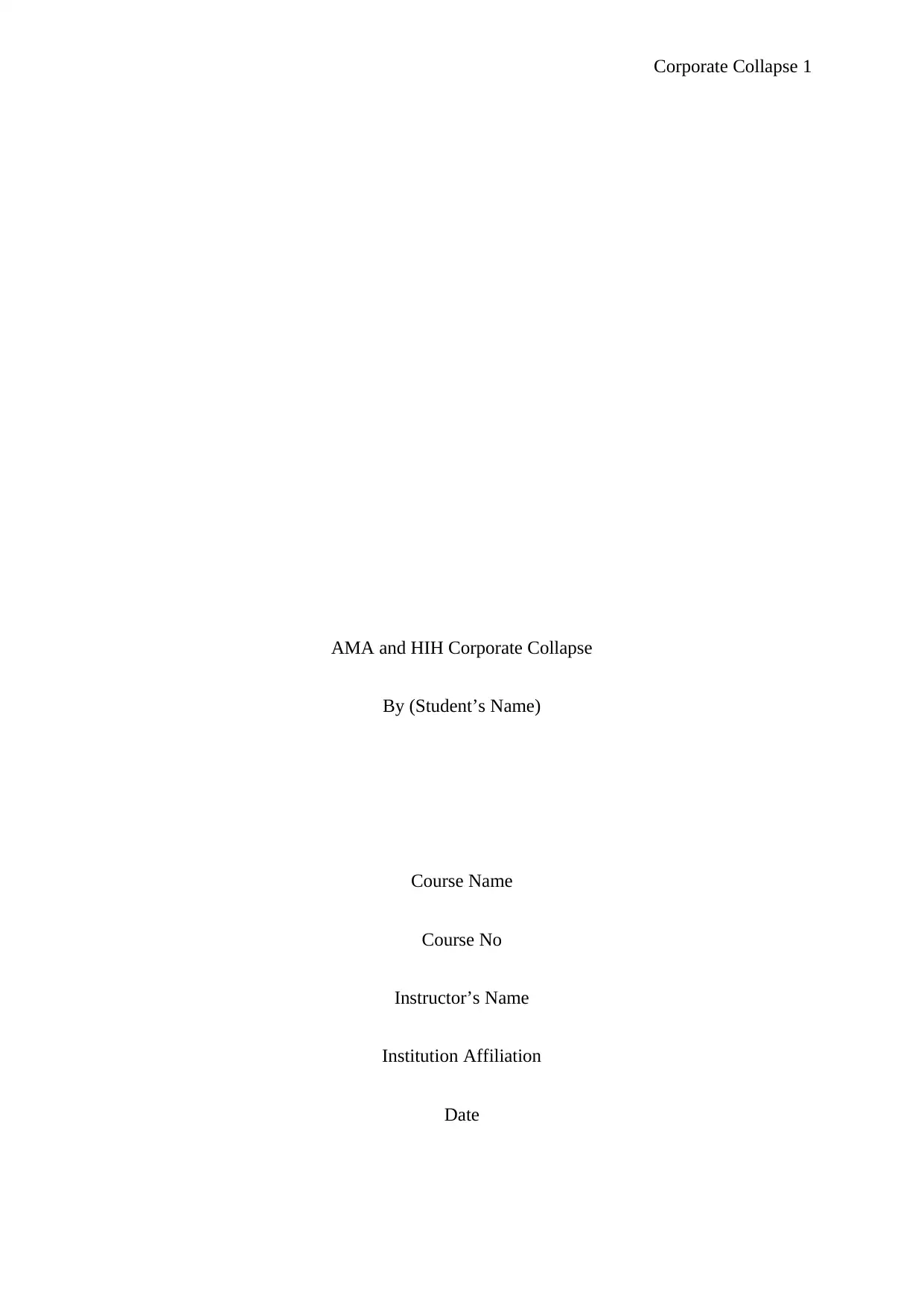
Corporate Collapse 1
AMA and HIH Corporate Collapse
By (Student’s Name)
Course Name
Course No
Instructor’s Name
Institution Affiliation
Date
AMA and HIH Corporate Collapse
By (Student’s Name)
Course Name
Course No
Instructor’s Name
Institution Affiliation
Date
Paraphrase This Document
Need a fresh take? Get an instant paraphrase of this document with our AI Paraphraser
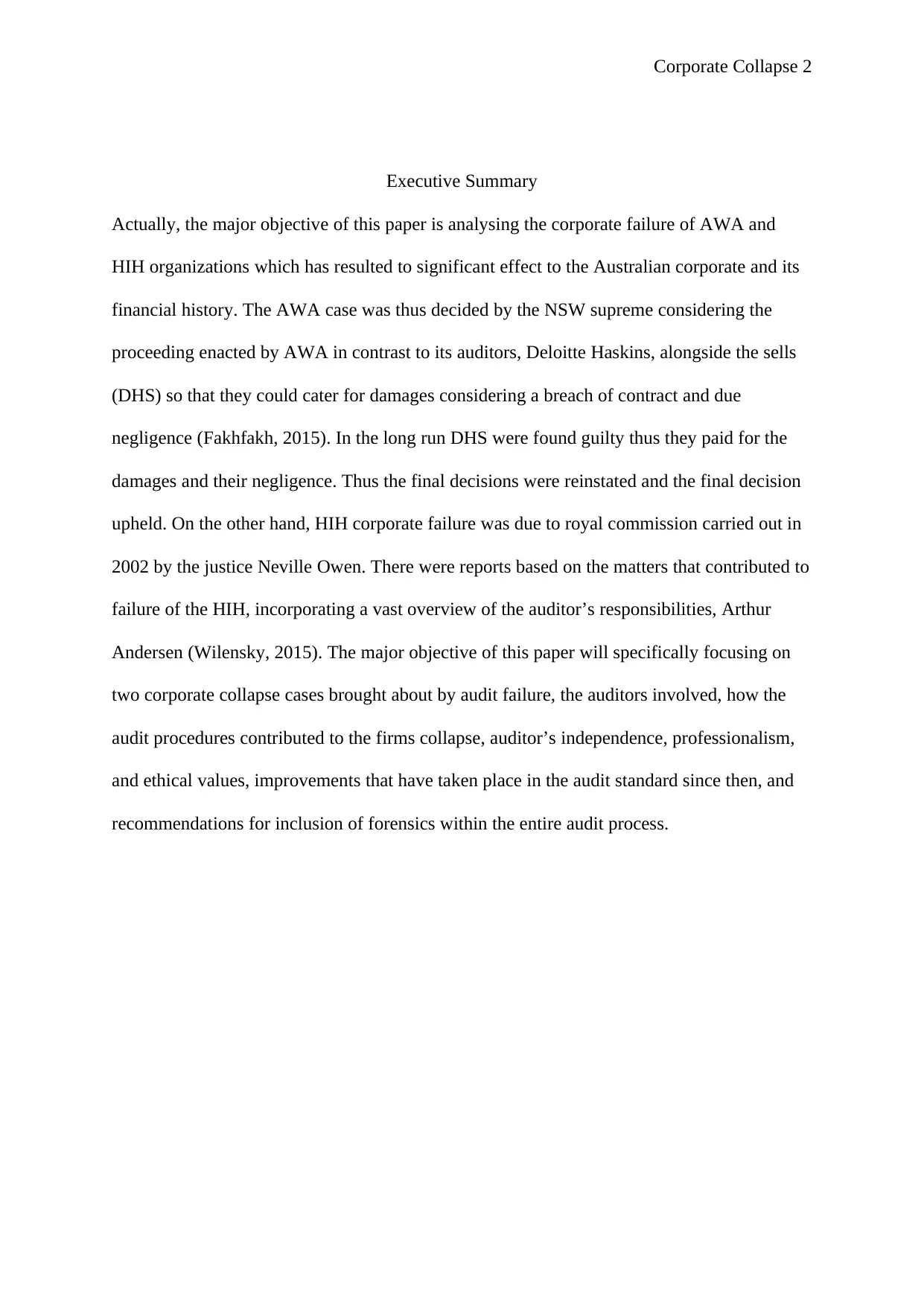
Corporate Collapse 2
Executive Summary
Actually, the major objective of this paper is analysing the corporate failure of AWA and
HIH organizations which has resulted to significant effect to the Australian corporate and its
financial history. The AWA case was thus decided by the NSW supreme considering the
proceeding enacted by AWA in contrast to its auditors, Deloitte Haskins, alongside the sells
(DHS) so that they could cater for damages considering a breach of contract and due
negligence (Fakhfakh, 2015). In the long run DHS were found guilty thus they paid for the
damages and their negligence. Thus the final decisions were reinstated and the final decision
upheld. On the other hand, HIH corporate failure was due to royal commission carried out in
2002 by the justice Neville Owen. There were reports based on the matters that contributed to
failure of the HIH, incorporating a vast overview of the auditor’s responsibilities, Arthur
Andersen (Wilensky, 2015). The major objective of this paper will specifically focusing on
two corporate collapse cases brought about by audit failure, the auditors involved, how the
audit procedures contributed to the firms collapse, auditor’s independence, professionalism,
and ethical values, improvements that have taken place in the audit standard since then, and
recommendations for inclusion of forensics within the entire audit process.
Executive Summary
Actually, the major objective of this paper is analysing the corporate failure of AWA and
HIH organizations which has resulted to significant effect to the Australian corporate and its
financial history. The AWA case was thus decided by the NSW supreme considering the
proceeding enacted by AWA in contrast to its auditors, Deloitte Haskins, alongside the sells
(DHS) so that they could cater for damages considering a breach of contract and due
negligence (Fakhfakh, 2015). In the long run DHS were found guilty thus they paid for the
damages and their negligence. Thus the final decisions were reinstated and the final decision
upheld. On the other hand, HIH corporate failure was due to royal commission carried out in
2002 by the justice Neville Owen. There were reports based on the matters that contributed to
failure of the HIH, incorporating a vast overview of the auditor’s responsibilities, Arthur
Andersen (Wilensky, 2015). The major objective of this paper will specifically focusing on
two corporate collapse cases brought about by audit failure, the auditors involved, how the
audit procedures contributed to the firms collapse, auditor’s independence, professionalism,
and ethical values, improvements that have taken place in the audit standard since then, and
recommendations for inclusion of forensics within the entire audit process.
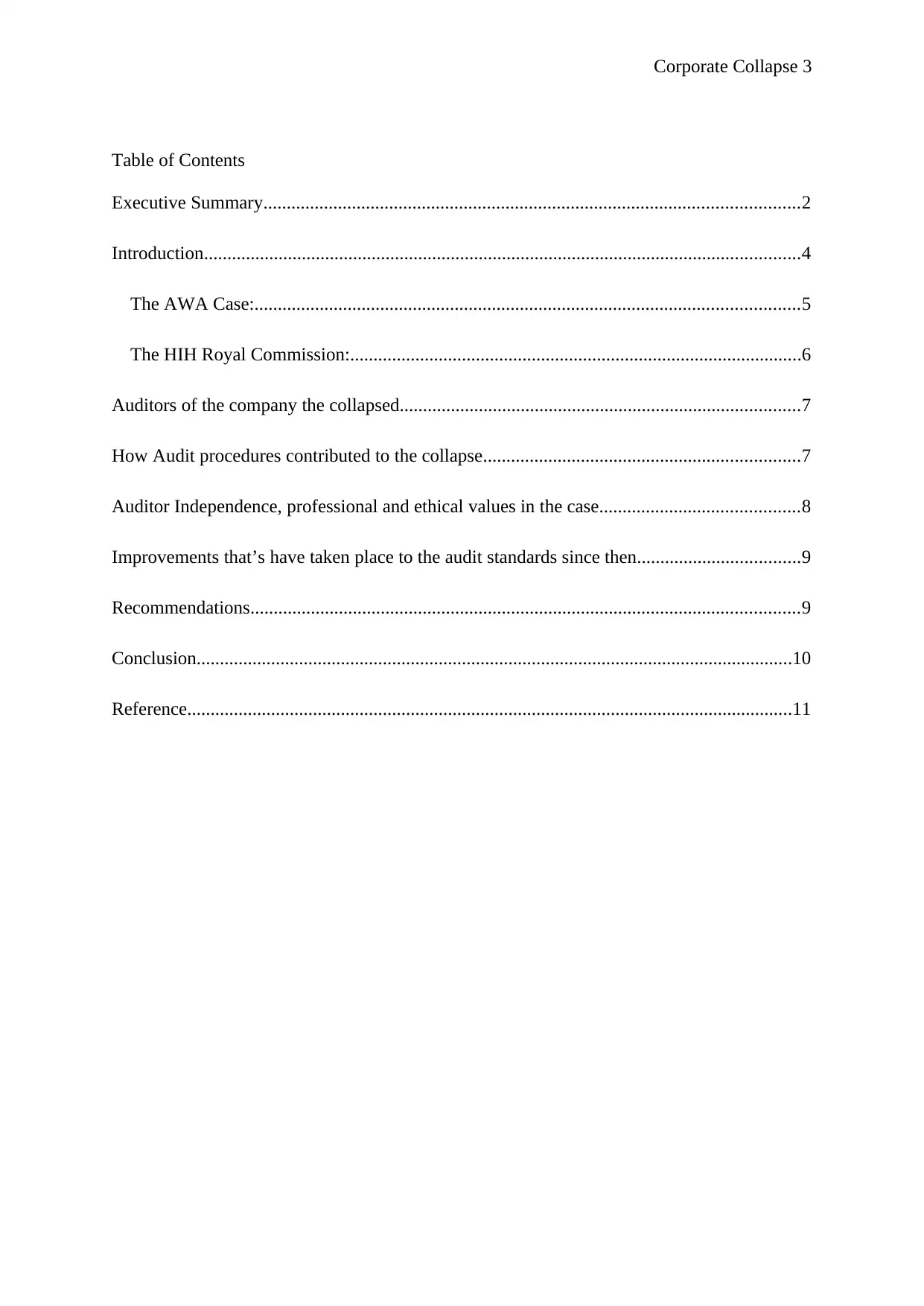
Corporate Collapse 3
Table of Contents
Executive Summary...................................................................................................................2
Introduction................................................................................................................................4
The AWA Case:.....................................................................................................................5
The HIH Royal Commission:.................................................................................................6
Auditors of the company the collapsed......................................................................................7
How Audit procedures contributed to the collapse....................................................................7
Auditor Independence, professional and ethical values in the case...........................................8
Improvements that’s have taken place to the audit standards since then...................................9
Recommendations......................................................................................................................9
Conclusion................................................................................................................................10
Reference..................................................................................................................................11
Table of Contents
Executive Summary...................................................................................................................2
Introduction................................................................................................................................4
The AWA Case:.....................................................................................................................5
The HIH Royal Commission:.................................................................................................6
Auditors of the company the collapsed......................................................................................7
How Audit procedures contributed to the collapse....................................................................7
Auditor Independence, professional and ethical values in the case...........................................8
Improvements that’s have taken place to the audit standards since then...................................9
Recommendations......................................................................................................................9
Conclusion................................................................................................................................10
Reference..................................................................................................................................11
⊘ This is a preview!⊘
Do you want full access?
Subscribe today to unlock all pages.

Trusted by 1+ million students worldwide
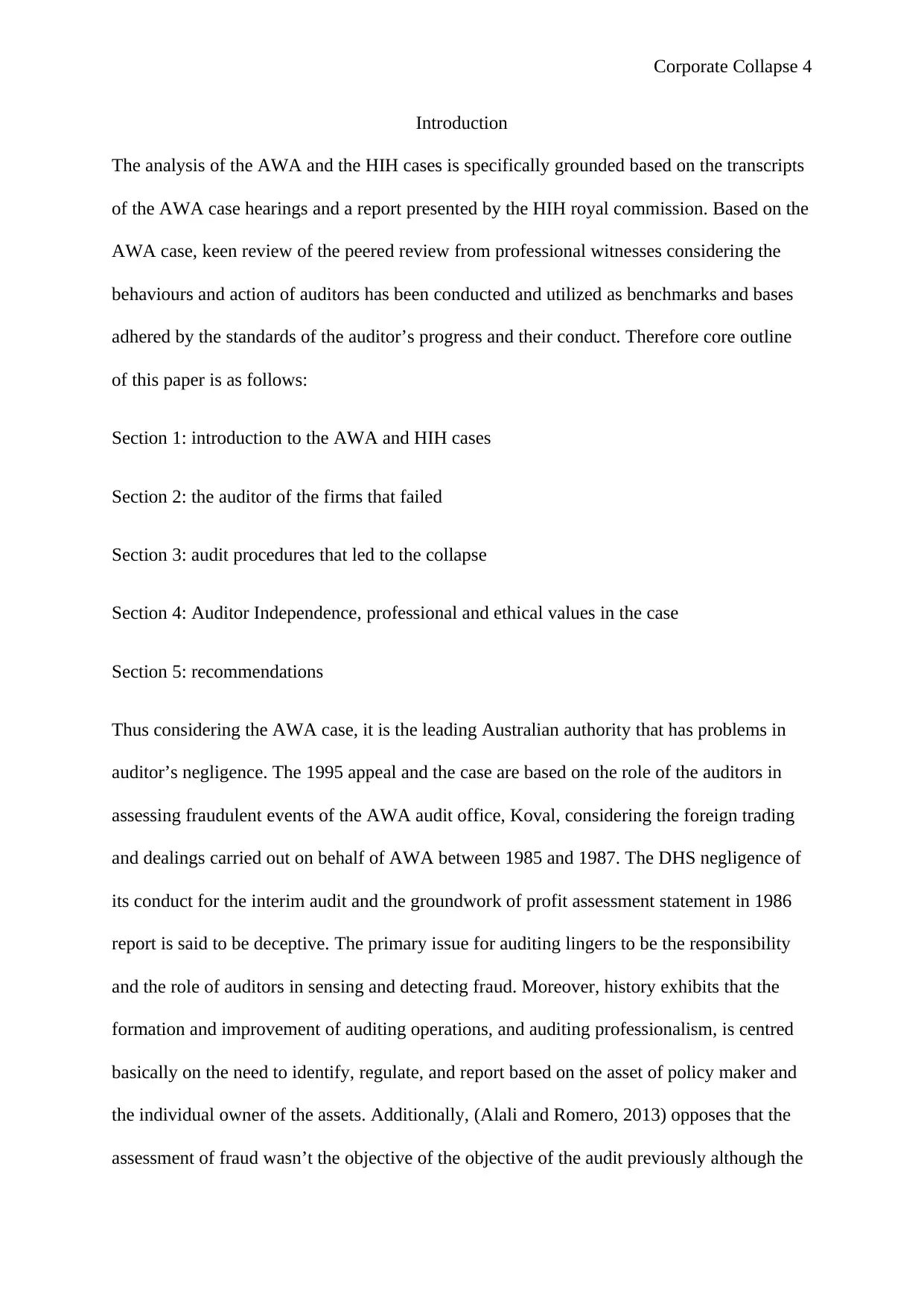
Corporate Collapse 4
Introduction
The analysis of the AWA and the HIH cases is specifically grounded based on the transcripts
of the AWA case hearings and a report presented by the HIH royal commission. Based on the
AWA case, keen review of the peered review from professional witnesses considering the
behaviours and action of auditors has been conducted and utilized as benchmarks and bases
adhered by the standards of the auditor’s progress and their conduct. Therefore core outline
of this paper is as follows:
Section 1: introduction to the AWA and HIH cases
Section 2: the auditor of the firms that failed
Section 3: audit procedures that led to the collapse
Section 4: Auditor Independence, professional and ethical values in the case
Section 5: recommendations
Thus considering the AWA case, it is the leading Australian authority that has problems in
auditor’s negligence. The 1995 appeal and the case are based on the role of the auditors in
assessing fraudulent events of the AWA audit office, Koval, considering the foreign trading
and dealings carried out on behalf of AWA between 1985 and 1987. The DHS negligence of
its conduct for the interim audit and the groundwork of profit assessment statement in 1986
report is said to be deceptive. The primary issue for auditing lingers to be the responsibility
and the role of auditors in sensing and detecting fraud. Moreover, history exhibits that the
formation and improvement of auditing operations, and auditing professionalism, is centred
basically on the need to identify, regulate, and report based on the asset of policy maker and
the individual owner of the assets. Additionally, (Alali and Romero, 2013) opposes that the
assessment of fraud wasn’t the objective of the objective of the audit previously although the
Introduction
The analysis of the AWA and the HIH cases is specifically grounded based on the transcripts
of the AWA case hearings and a report presented by the HIH royal commission. Based on the
AWA case, keen review of the peered review from professional witnesses considering the
behaviours and action of auditors has been conducted and utilized as benchmarks and bases
adhered by the standards of the auditor’s progress and their conduct. Therefore core outline
of this paper is as follows:
Section 1: introduction to the AWA and HIH cases
Section 2: the auditor of the firms that failed
Section 3: audit procedures that led to the collapse
Section 4: Auditor Independence, professional and ethical values in the case
Section 5: recommendations
Thus considering the AWA case, it is the leading Australian authority that has problems in
auditor’s negligence. The 1995 appeal and the case are based on the role of the auditors in
assessing fraudulent events of the AWA audit office, Koval, considering the foreign trading
and dealings carried out on behalf of AWA between 1985 and 1987. The DHS negligence of
its conduct for the interim audit and the groundwork of profit assessment statement in 1986
report is said to be deceptive. The primary issue for auditing lingers to be the responsibility
and the role of auditors in sensing and detecting fraud. Moreover, history exhibits that the
formation and improvement of auditing operations, and auditing professionalism, is centred
basically on the need to identify, regulate, and report based on the asset of policy maker and
the individual owner of the assets. Additionally, (Alali and Romero, 2013) opposes that the
assessment of fraud wasn’t the objective of the objective of the audit previously although the
Paraphrase This Document
Need a fresh take? Get an instant paraphrase of this document with our AI Paraphraser
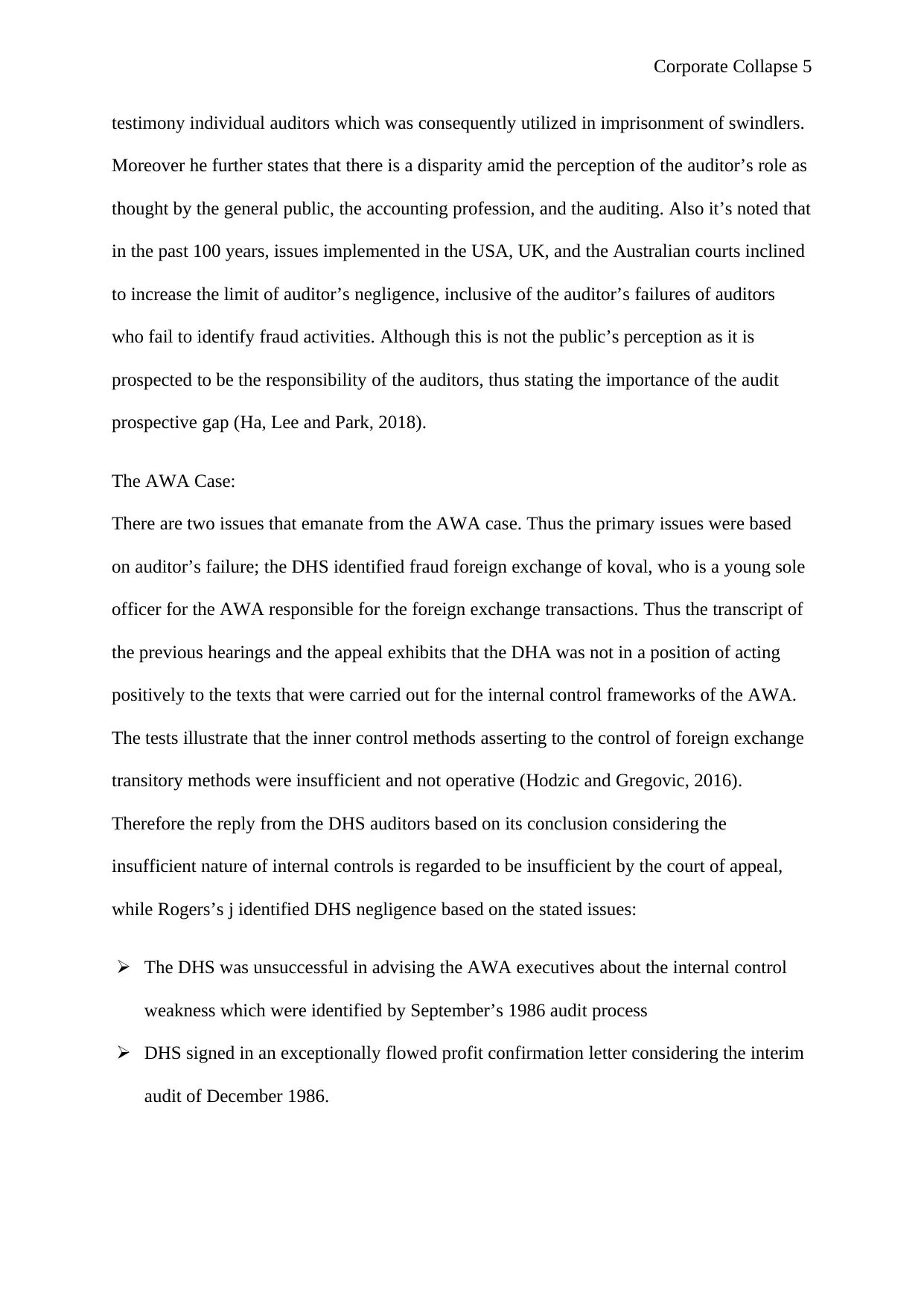
Corporate Collapse 5
testimony individual auditors which was consequently utilized in imprisonment of swindlers.
Moreover he further states that there is a disparity amid the perception of the auditor’s role as
thought by the general public, the accounting profession, and the auditing. Also it’s noted that
in the past 100 years, issues implemented in the USA, UK, and the Australian courts inclined
to increase the limit of auditor’s negligence, inclusive of the auditor’s failures of auditors
who fail to identify fraud activities. Although this is not the public’s perception as it is
prospected to be the responsibility of the auditors, thus stating the importance of the audit
prospective gap (Ha, Lee and Park, 2018).
The AWA Case:
There are two issues that emanate from the AWA case. Thus the primary issues were based
on auditor’s failure; the DHS identified fraud foreign exchange of koval, who is a young sole
officer for the AWA responsible for the foreign exchange transactions. Thus the transcript of
the previous hearings and the appeal exhibits that the DHA was not in a position of acting
positively to the texts that were carried out for the internal control frameworks of the AWA.
The tests illustrate that the inner control methods asserting to the control of foreign exchange
transitory methods were insufficient and not operative (Hodzic and Gregovic, 2016).
Therefore the reply from the DHS auditors based on its conclusion considering the
insufficient nature of internal controls is regarded to be insufficient by the court of appeal,
while Rogers’s j identified DHS negligence based on the stated issues:
The DHS was unsuccessful in advising the AWA executives about the internal control
weakness which were identified by September’s 1986 audit process
DHS signed in an exceptionally flowed profit confirmation letter considering the interim
audit of December 1986.
testimony individual auditors which was consequently utilized in imprisonment of swindlers.
Moreover he further states that there is a disparity amid the perception of the auditor’s role as
thought by the general public, the accounting profession, and the auditing. Also it’s noted that
in the past 100 years, issues implemented in the USA, UK, and the Australian courts inclined
to increase the limit of auditor’s negligence, inclusive of the auditor’s failures of auditors
who fail to identify fraud activities. Although this is not the public’s perception as it is
prospected to be the responsibility of the auditors, thus stating the importance of the audit
prospective gap (Ha, Lee and Park, 2018).
The AWA Case:
There are two issues that emanate from the AWA case. Thus the primary issues were based
on auditor’s failure; the DHS identified fraud foreign exchange of koval, who is a young sole
officer for the AWA responsible for the foreign exchange transactions. Thus the transcript of
the previous hearings and the appeal exhibits that the DHA was not in a position of acting
positively to the texts that were carried out for the internal control frameworks of the AWA.
The tests illustrate that the inner control methods asserting to the control of foreign exchange
transitory methods were insufficient and not operative (Hodzic and Gregovic, 2016).
Therefore the reply from the DHS auditors based on its conclusion considering the
insufficient nature of internal controls is regarded to be insufficient by the court of appeal,
while Rogers’s j identified DHS negligence based on the stated issues:
The DHS was unsuccessful in advising the AWA executives about the internal control
weakness which were identified by September’s 1986 audit process
DHS signed in an exceptionally flowed profit confirmation letter considering the interim
audit of December 1986.
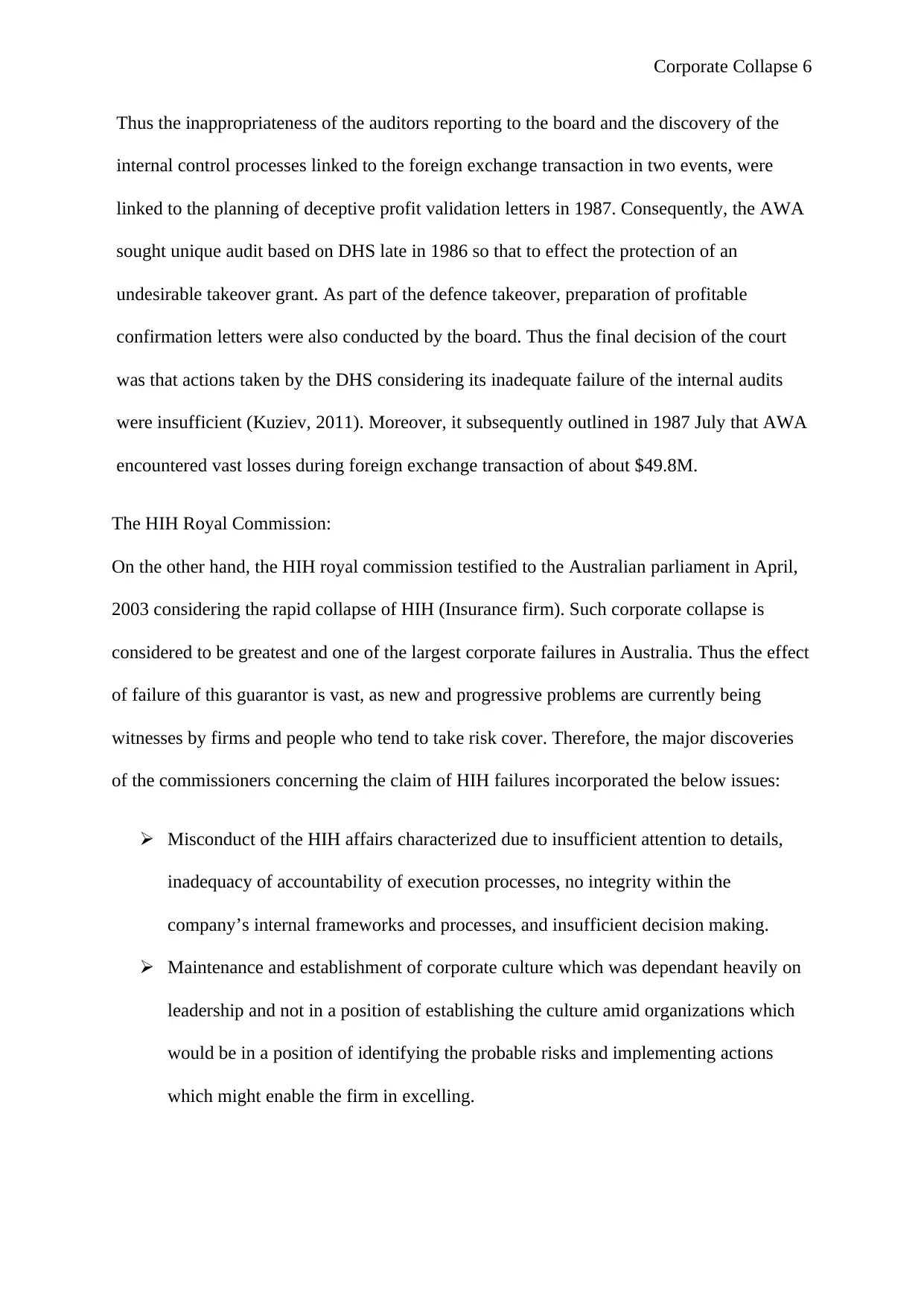
Corporate Collapse 6
Thus the inappropriateness of the auditors reporting to the board and the discovery of the
internal control processes linked to the foreign exchange transaction in two events, were
linked to the planning of deceptive profit validation letters in 1987. Consequently, the AWA
sought unique audit based on DHS late in 1986 so that to effect the protection of an
undesirable takeover grant. As part of the defence takeover, preparation of profitable
confirmation letters were also conducted by the board. Thus the final decision of the court
was that actions taken by the DHS considering its inadequate failure of the internal audits
were insufficient (Kuziev, 2011). Moreover, it subsequently outlined in 1987 July that AWA
encountered vast losses during foreign exchange transaction of about $49.8M.
The HIH Royal Commission:
On the other hand, the HIH royal commission testified to the Australian parliament in April,
2003 considering the rapid collapse of HIH (Insurance firm). Such corporate collapse is
considered to be greatest and one of the largest corporate failures in Australia. Thus the effect
of failure of this guarantor is vast, as new and progressive problems are currently being
witnesses by firms and people who tend to take risk cover. Therefore, the major discoveries
of the commissioners concerning the claim of HIH failures incorporated the below issues:
Misconduct of the HIH affairs characterized due to insufficient attention to details,
inadequacy of accountability of execution processes, no integrity within the
company’s internal frameworks and processes, and insufficient decision making.
Maintenance and establishment of corporate culture which was dependant heavily on
leadership and not in a position of establishing the culture amid organizations which
would be in a position of identifying the probable risks and implementing actions
which might enable the firm in excelling.
Thus the inappropriateness of the auditors reporting to the board and the discovery of the
internal control processes linked to the foreign exchange transaction in two events, were
linked to the planning of deceptive profit validation letters in 1987. Consequently, the AWA
sought unique audit based on DHS late in 1986 so that to effect the protection of an
undesirable takeover grant. As part of the defence takeover, preparation of profitable
confirmation letters were also conducted by the board. Thus the final decision of the court
was that actions taken by the DHS considering its inadequate failure of the internal audits
were insufficient (Kuziev, 2011). Moreover, it subsequently outlined in 1987 July that AWA
encountered vast losses during foreign exchange transaction of about $49.8M.
The HIH Royal Commission:
On the other hand, the HIH royal commission testified to the Australian parliament in April,
2003 considering the rapid collapse of HIH (Insurance firm). Such corporate collapse is
considered to be greatest and one of the largest corporate failures in Australia. Thus the effect
of failure of this guarantor is vast, as new and progressive problems are currently being
witnesses by firms and people who tend to take risk cover. Therefore, the major discoveries
of the commissioners concerning the claim of HIH failures incorporated the below issues:
Misconduct of the HIH affairs characterized due to insufficient attention to details,
inadequacy of accountability of execution processes, no integrity within the
company’s internal frameworks and processes, and insufficient decision making.
Maintenance and establishment of corporate culture which was dependant heavily on
leadership and not in a position of establishing the culture amid organizations which
would be in a position of identifying the probable risks and implementing actions
which might enable the firm in excelling.
⊘ This is a preview!⊘
Do you want full access?
Subscribe today to unlock all pages.

Trusted by 1+ million students worldwide
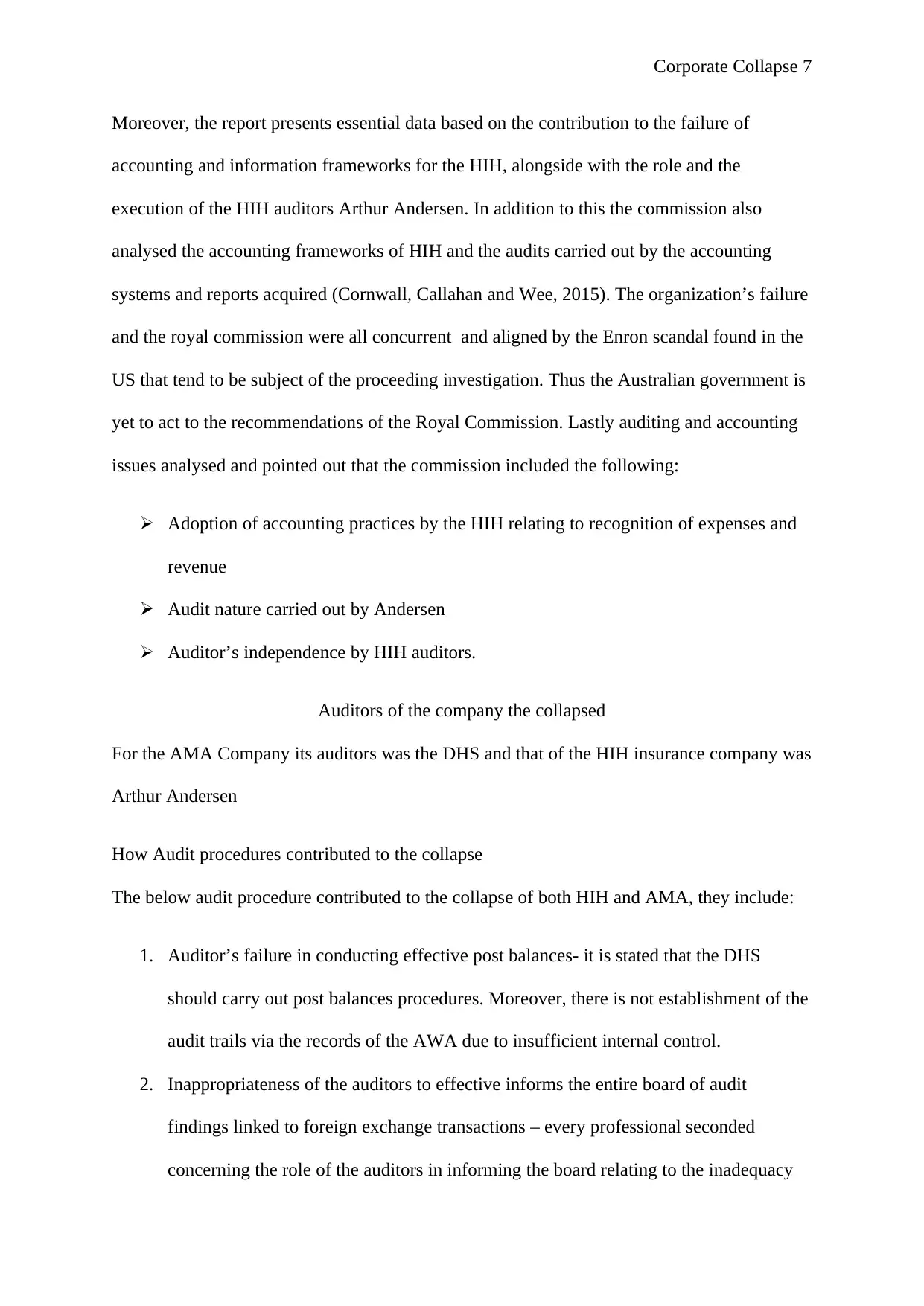
Corporate Collapse 7
Moreover, the report presents essential data based on the contribution to the failure of
accounting and information frameworks for the HIH, alongside with the role and the
execution of the HIH auditors Arthur Andersen. In addition to this the commission also
analysed the accounting frameworks of HIH and the audits carried out by the accounting
systems and reports acquired (Cornwall, Callahan and Wee, 2015). The organization’s failure
and the royal commission were all concurrent and aligned by the Enron scandal found in the
US that tend to be subject of the proceeding investigation. Thus the Australian government is
yet to act to the recommendations of the Royal Commission. Lastly auditing and accounting
issues analysed and pointed out that the commission included the following:
Adoption of accounting practices by the HIH relating to recognition of expenses and
revenue
Audit nature carried out by Andersen
Auditor’s independence by HIH auditors.
Auditors of the company the collapsed
For the AMA Company its auditors was the DHS and that of the HIH insurance company was
Arthur Andersen
How Audit procedures contributed to the collapse
The below audit procedure contributed to the collapse of both HIH and AMA, they include:
1. Auditor’s failure in conducting effective post balances- it is stated that the DHS
should carry out post balances procedures. Moreover, there is not establishment of the
audit trails via the records of the AWA due to insufficient internal control.
2. Inappropriateness of the auditors to effective informs the entire board of audit
findings linked to foreign exchange transactions – every professional seconded
concerning the role of the auditors in informing the board relating to the inadequacy
Moreover, the report presents essential data based on the contribution to the failure of
accounting and information frameworks for the HIH, alongside with the role and the
execution of the HIH auditors Arthur Andersen. In addition to this the commission also
analysed the accounting frameworks of HIH and the audits carried out by the accounting
systems and reports acquired (Cornwall, Callahan and Wee, 2015). The organization’s failure
and the royal commission were all concurrent and aligned by the Enron scandal found in the
US that tend to be subject of the proceeding investigation. Thus the Australian government is
yet to act to the recommendations of the Royal Commission. Lastly auditing and accounting
issues analysed and pointed out that the commission included the following:
Adoption of accounting practices by the HIH relating to recognition of expenses and
revenue
Audit nature carried out by Andersen
Auditor’s independence by HIH auditors.
Auditors of the company the collapsed
For the AMA Company its auditors was the DHS and that of the HIH insurance company was
Arthur Andersen
How Audit procedures contributed to the collapse
The below audit procedure contributed to the collapse of both HIH and AMA, they include:
1. Auditor’s failure in conducting effective post balances- it is stated that the DHS
should carry out post balances procedures. Moreover, there is not establishment of the
audit trails via the records of the AWA due to insufficient internal control.
2. Inappropriateness of the auditors to effective informs the entire board of audit
findings linked to foreign exchange transactions – every professional seconded
concerning the role of the auditors in informing the board relating to the inadequacy
Paraphrase This Document
Need a fresh take? Get an instant paraphrase of this document with our AI Paraphraser
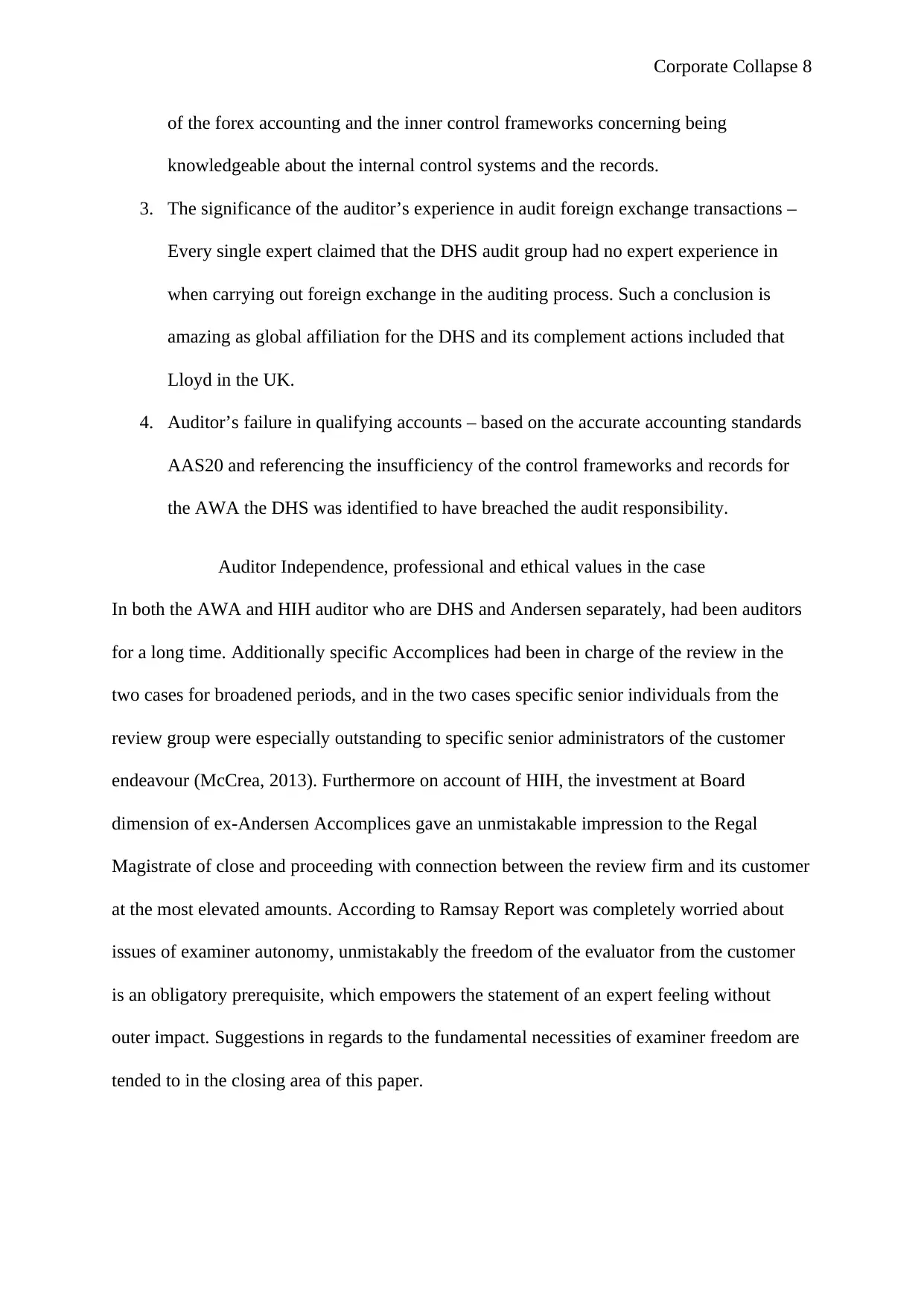
Corporate Collapse 8
of the forex accounting and the inner control frameworks concerning being
knowledgeable about the internal control systems and the records.
3. The significance of the auditor’s experience in audit foreign exchange transactions –
Every single expert claimed that the DHS audit group had no expert experience in
when carrying out foreign exchange in the auditing process. Such a conclusion is
amazing as global affiliation for the DHS and its complement actions included that
Lloyd in the UK.
4. Auditor’s failure in qualifying accounts – based on the accurate accounting standards
AAS20 and referencing the insufficiency of the control frameworks and records for
the AWA the DHS was identified to have breached the audit responsibility.
Auditor Independence, professional and ethical values in the case
In both the AWA and HIH auditor who are DHS and Andersen separately, had been auditors
for a long time. Additionally specific Accomplices had been in charge of the review in the
two cases for broadened periods, and in the two cases specific senior individuals from the
review group were especially outstanding to specific senior administrators of the customer
endeavour (McCrea, 2013). Furthermore on account of HIH, the investment at Board
dimension of ex-Andersen Accomplices gave an unmistakable impression to the Regal
Magistrate of close and proceeding with connection between the review firm and its customer
at the most elevated amounts. According to Ramsay Report was completely worried about
issues of examiner autonomy, unmistakably the freedom of the evaluator from the customer
is an obligatory prerequisite, which empowers the statement of an expert feeling without
outer impact. Suggestions in regards to the fundamental necessities of examiner freedom are
tended to in the closing area of this paper.
of the forex accounting and the inner control frameworks concerning being
knowledgeable about the internal control systems and the records.
3. The significance of the auditor’s experience in audit foreign exchange transactions –
Every single expert claimed that the DHS audit group had no expert experience in
when carrying out foreign exchange in the auditing process. Such a conclusion is
amazing as global affiliation for the DHS and its complement actions included that
Lloyd in the UK.
4. Auditor’s failure in qualifying accounts – based on the accurate accounting standards
AAS20 and referencing the insufficiency of the control frameworks and records for
the AWA the DHS was identified to have breached the audit responsibility.
Auditor Independence, professional and ethical values in the case
In both the AWA and HIH auditor who are DHS and Andersen separately, had been auditors
for a long time. Additionally specific Accomplices had been in charge of the review in the
two cases for broadened periods, and in the two cases specific senior individuals from the
review group were especially outstanding to specific senior administrators of the customer
endeavour (McCrea, 2013). Furthermore on account of HIH, the investment at Board
dimension of ex-Andersen Accomplices gave an unmistakable impression to the Regal
Magistrate of close and proceeding with connection between the review firm and its customer
at the most elevated amounts. According to Ramsay Report was completely worried about
issues of examiner autonomy, unmistakably the freedom of the evaluator from the customer
is an obligatory prerequisite, which empowers the statement of an expert feeling without
outer impact. Suggestions in regards to the fundamental necessities of examiner freedom are
tended to in the closing area of this paper.
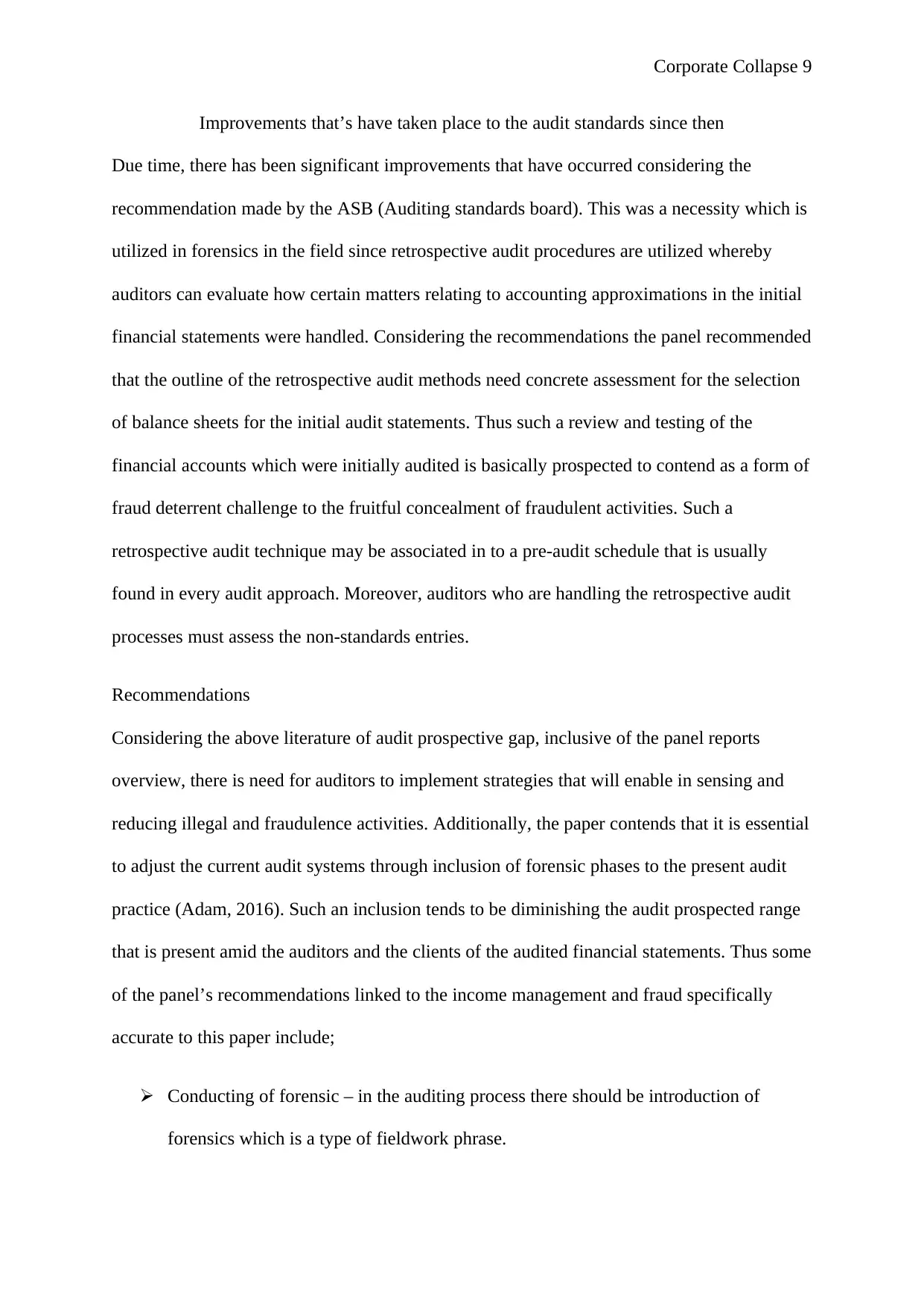
Corporate Collapse 9
Improvements that’s have taken place to the audit standards since then
Due time, there has been significant improvements that have occurred considering the
recommendation made by the ASB (Auditing standards board). This was a necessity which is
utilized in forensics in the field since retrospective audit procedures are utilized whereby
auditors can evaluate how certain matters relating to accounting approximations in the initial
financial statements were handled. Considering the recommendations the panel recommended
that the outline of the retrospective audit methods need concrete assessment for the selection
of balance sheets for the initial audit statements. Thus such a review and testing of the
financial accounts which were initially audited is basically prospected to contend as a form of
fraud deterrent challenge to the fruitful concealment of fraudulent activities. Such a
retrospective audit technique may be associated in to a pre-audit schedule that is usually
found in every audit approach. Moreover, auditors who are handling the retrospective audit
processes must assess the non-standards entries.
Recommendations
Considering the above literature of audit prospective gap, inclusive of the panel reports
overview, there is need for auditors to implement strategies that will enable in sensing and
reducing illegal and fraudulence activities. Additionally, the paper contends that it is essential
to adjust the current audit systems through inclusion of forensic phases to the present audit
practice (Adam, 2016). Such an inclusion tends to be diminishing the audit prospected range
that is present amid the auditors and the clients of the audited financial statements. Thus some
of the panel’s recommendations linked to the income management and fraud specifically
accurate to this paper include;
Conducting of forensic – in the auditing process there should be introduction of
forensics which is a type of fieldwork phrase.
Improvements that’s have taken place to the audit standards since then
Due time, there has been significant improvements that have occurred considering the
recommendation made by the ASB (Auditing standards board). This was a necessity which is
utilized in forensics in the field since retrospective audit procedures are utilized whereby
auditors can evaluate how certain matters relating to accounting approximations in the initial
financial statements were handled. Considering the recommendations the panel recommended
that the outline of the retrospective audit methods need concrete assessment for the selection
of balance sheets for the initial audit statements. Thus such a review and testing of the
financial accounts which were initially audited is basically prospected to contend as a form of
fraud deterrent challenge to the fruitful concealment of fraudulent activities. Such a
retrospective audit technique may be associated in to a pre-audit schedule that is usually
found in every audit approach. Moreover, auditors who are handling the retrospective audit
processes must assess the non-standards entries.
Recommendations
Considering the above literature of audit prospective gap, inclusive of the panel reports
overview, there is need for auditors to implement strategies that will enable in sensing and
reducing illegal and fraudulence activities. Additionally, the paper contends that it is essential
to adjust the current audit systems through inclusion of forensic phases to the present audit
practice (Adam, 2016). Such an inclusion tends to be diminishing the audit prospected range
that is present amid the auditors and the clients of the audited financial statements. Thus some
of the panel’s recommendations linked to the income management and fraud specifically
accurate to this paper include;
Conducting of forensic – in the auditing process there should be introduction of
forensics which is a type of fieldwork phrase.
⊘ This is a preview!⊘
Do you want full access?
Subscribe today to unlock all pages.

Trusted by 1+ million students worldwide
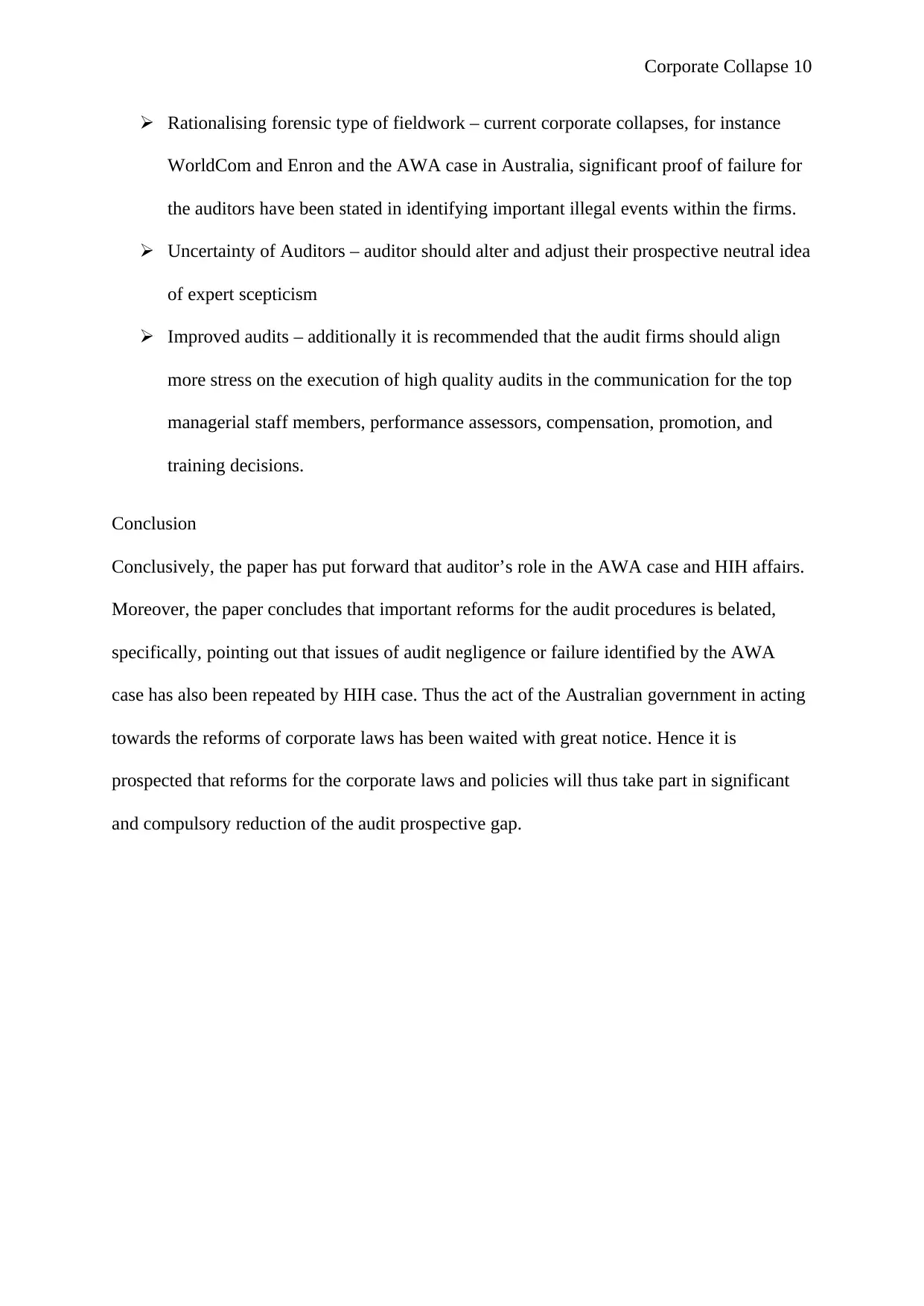
Corporate Collapse 10
Rationalising forensic type of fieldwork – current corporate collapses, for instance
WorldCom and Enron and the AWA case in Australia, significant proof of failure for
the auditors have been stated in identifying important illegal events within the firms.
Uncertainty of Auditors – auditor should alter and adjust their prospective neutral idea
of expert scepticism
Improved audits – additionally it is recommended that the audit firms should align
more stress on the execution of high quality audits in the communication for the top
managerial staff members, performance assessors, compensation, promotion, and
training decisions.
Conclusion
Conclusively, the paper has put forward that auditor’s role in the AWA case and HIH affairs.
Moreover, the paper concludes that important reforms for the audit procedures is belated,
specifically, pointing out that issues of audit negligence or failure identified by the AWA
case has also been repeated by HIH case. Thus the act of the Australian government in acting
towards the reforms of corporate laws has been waited with great notice. Hence it is
prospected that reforms for the corporate laws and policies will thus take part in significant
and compulsory reduction of the audit prospective gap.
Rationalising forensic type of fieldwork – current corporate collapses, for instance
WorldCom and Enron and the AWA case in Australia, significant proof of failure for
the auditors have been stated in identifying important illegal events within the firms.
Uncertainty of Auditors – auditor should alter and adjust their prospective neutral idea
of expert scepticism
Improved audits – additionally it is recommended that the audit firms should align
more stress on the execution of high quality audits in the communication for the top
managerial staff members, performance assessors, compensation, promotion, and
training decisions.
Conclusion
Conclusively, the paper has put forward that auditor’s role in the AWA case and HIH affairs.
Moreover, the paper concludes that important reforms for the audit procedures is belated,
specifically, pointing out that issues of audit negligence or failure identified by the AWA
case has also been repeated by HIH case. Thus the act of the Australian government in acting
towards the reforms of corporate laws has been waited with great notice. Hence it is
prospected that reforms for the corporate laws and policies will thus take part in significant
and compulsory reduction of the audit prospective gap.
Paraphrase This Document
Need a fresh take? Get an instant paraphrase of this document with our AI Paraphraser
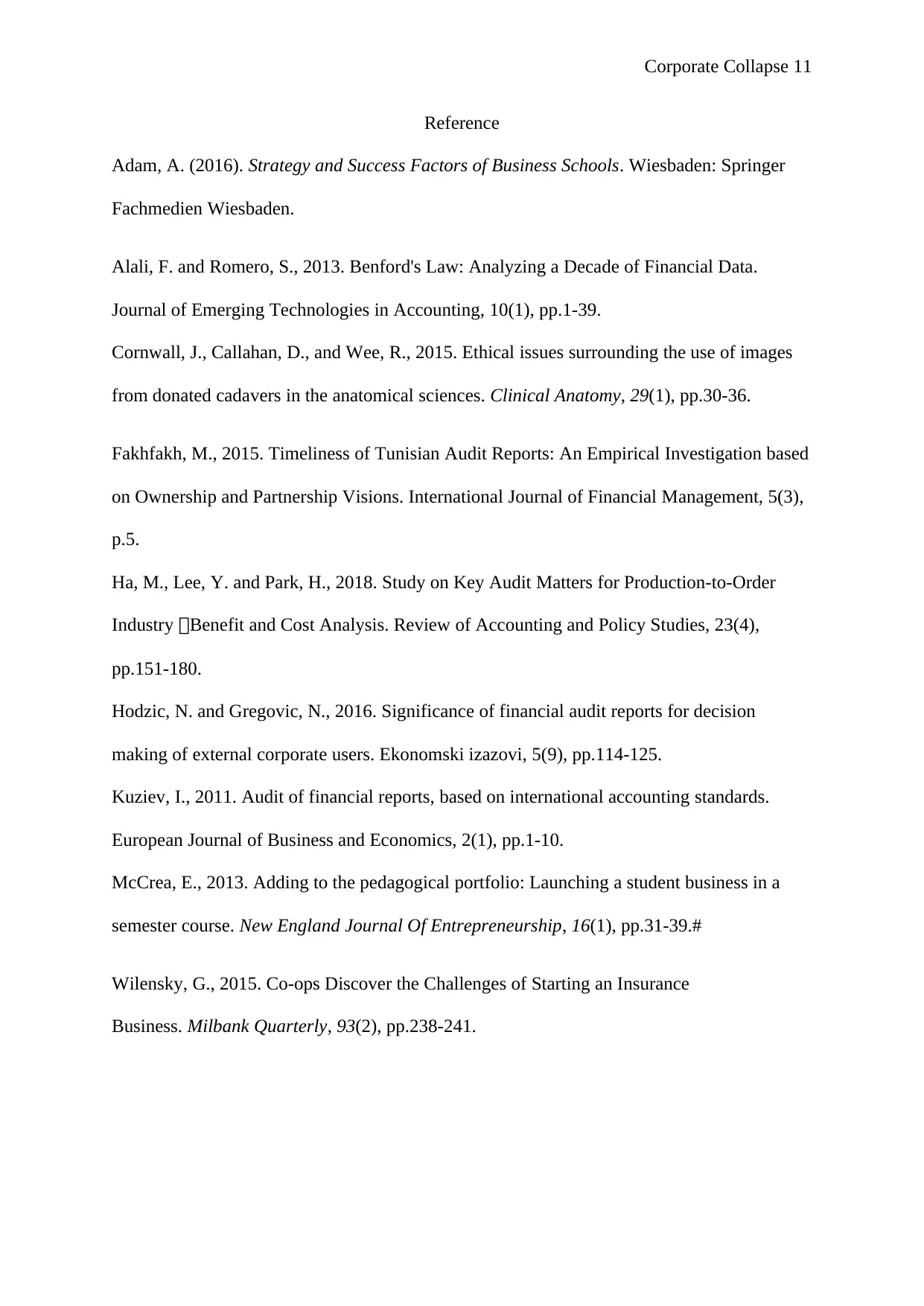
Corporate Collapse 11
Reference
Adam, A. (2016). Strategy and Success Factors of Business Schools. Wiesbaden: Springer
Fachmedien Wiesbaden.
Alali, F. and Romero, S., 2013. Benford's Law: Analyzing a Decade of Financial Data.
Journal of Emerging Technologies in Accounting, 10(1), pp.1-39.
Cornwall, J., Callahan, D., and Wee, R., 2015. Ethical issues surrounding the use of images
from donated cadavers in the anatomical sciences. Clinical Anatomy, 29(1), pp.30-36.
Fakhfakh, M., 2015. Timeliness of Tunisian Audit Reports: An Empirical Investigation based
on Ownership and Partnership Visions. International Journal of Financial Management, 5(3),
p.5.
Ha, M., Lee, Y. and Park, H., 2018. Study on Key Audit Matters for Production-to-Order
Industry :Benefit and Cost Analysis. Review of Accounting and Policy Studies, 23(4),
pp.151-180.
Hodzic, N. and Gregovic, N., 2016. Significance of financial audit reports for decision
making of external corporate users. Ekonomski izazovi, 5(9), pp.114-125.
Kuziev, I., 2011. Audit of financial reports, based on international accounting standards.
European Journal of Business and Economics, 2(1), pp.1-10.
McCrea, E., 2013. Adding to the pedagogical portfolio: Launching a student business in a
semester course. New England Journal Of Entrepreneurship, 16(1), pp.31-39.#
Wilensky, G., 2015. Co-ops Discover the Challenges of Starting an Insurance
Business. Milbank Quarterly, 93(2), pp.238-241.
Reference
Adam, A. (2016). Strategy and Success Factors of Business Schools. Wiesbaden: Springer
Fachmedien Wiesbaden.
Alali, F. and Romero, S., 2013. Benford's Law: Analyzing a Decade of Financial Data.
Journal of Emerging Technologies in Accounting, 10(1), pp.1-39.
Cornwall, J., Callahan, D., and Wee, R., 2015. Ethical issues surrounding the use of images
from donated cadavers in the anatomical sciences. Clinical Anatomy, 29(1), pp.30-36.
Fakhfakh, M., 2015. Timeliness of Tunisian Audit Reports: An Empirical Investigation based
on Ownership and Partnership Visions. International Journal of Financial Management, 5(3),
p.5.
Ha, M., Lee, Y. and Park, H., 2018. Study on Key Audit Matters for Production-to-Order
Industry :Benefit and Cost Analysis. Review of Accounting and Policy Studies, 23(4),
pp.151-180.
Hodzic, N. and Gregovic, N., 2016. Significance of financial audit reports for decision
making of external corporate users. Ekonomski izazovi, 5(9), pp.114-125.
Kuziev, I., 2011. Audit of financial reports, based on international accounting standards.
European Journal of Business and Economics, 2(1), pp.1-10.
McCrea, E., 2013. Adding to the pedagogical portfolio: Launching a student business in a
semester course. New England Journal Of Entrepreneurship, 16(1), pp.31-39.#
Wilensky, G., 2015. Co-ops Discover the Challenges of Starting an Insurance
Business. Milbank Quarterly, 93(2), pp.238-241.
1 out of 11
Related Documents
Your All-in-One AI-Powered Toolkit for Academic Success.
+13062052269
info@desklib.com
Available 24*7 on WhatsApp / Email
![[object Object]](/_next/static/media/star-bottom.7253800d.svg)
Unlock your academic potential
Copyright © 2020–2025 A2Z Services. All Rights Reserved. Developed and managed by ZUCOL.





